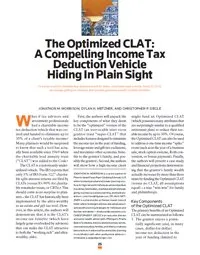Amid continued volatility in the medical industry, Arizona is experiencing increased consolidation in the health sector.
As a growing number of medical practices merge with larger medical groups or sell to hospitals, many physicians are left with a critical quandary: How can the physician selling her practice not only maximize the profit from the sale, but also preserve and protect her wealth and continue her legacy after the sale?
After all, capital taxes from the sale (which are often the largest expense of the transaction, swiftly eroding profitability) can damper what should otherwise be the rewarding culmination of years of hard work. Then, whatever is left still remains subject to risk from creditors and lawsuits, as well as federal estate tax at death.
By utilizing a savvy tax planning strategy known as an “Optimized Charitable Lead Annuity Trust” (OCLAT), the physician can:
- save up to 30% of the taxes from the sale;
- remain in full control of investing the contributed funds (much like a self-directed IRA);
- fund charitable causes in furtherance of her legacy; and
- transfer to heirs (or receive back) significant wealth in the future – a quintessential win-win.
Specifically:
- The physician receives a federal and state income tax deduction equal to the amount contributed to the OCLAT, subject to a 30% AGI limitation (i.e., a physician selling his practice for $10 million may contribute up to $3 million to the OCLAT, reducing taxable income from $10 million to $7 million).
- The assets contributed to the OCLAT are exempt from the physician’s personal creditors, lawsuits, and bankruptcy (and future divorce if the OCLAT is funded while single).
- After the required charitable payments are made, the assets remaining inside the OCLAT account should be 2-5 times the amount of the initial contribution (assuming a conservative 5-7% investment rate of return), which assets may be transferred back to the physician (free of income taxes) or transferred to the physician’s heirs (free of income taxes and free of the 40% gift/estate tax).
For instance, consider Dr. Smith, a philanthropic surgeon selling her practice in 2023 for $5 million and paying taxes at the top income tax bracket (roughly 50% when accounting for state and federal taxes).
Dr. Smith opens a self-managed OCLAT account at her bank and transfers $1 million of assets (stocks, bonds, digital currency, etc.) into the OCLAT account. The transfer of $1 million to the OCLAT unlocks an immediate $1 million income tax deduction, saving her roughly $500,000 in taxes on her 2023 tax return.
Over the charitable term selected by Dr. Smith (let’s assume 30 years), Dr. Smith will invest the $1 million inside the OCLAT, and will also be required to make annual donations to her favorite charities. The required donation amount is set by the IRS based on interest rates in effect at the time of funding. These rates are currently at a historically low level, making the OCLAT even more advantageous. In this way, the trust will simultaneously bolster Dr. Smith’s philanthropic legacy and compound her investments.
At year 30, after Dr. Smith has donated about $2.5 million from the OCLAT account, there will be about $5 million remaining (assuming a 7.5% annual rate of return). This amount may be transferred back to Dr. Smith (income tax-free), and/or she may elect to transfer all or a portion of the $5 million to her children (income tax-free and without the 40% gift tax).
Alternatively, rather than wait until year 30 (especially if the investments have performed exceptionally well in a “homerun CLAT”), Dr. Smith may choose to prepay the $2.5 million donations and access the remaining OCLAT assets ahead of schedule.
OCLATs perform so well that some physicians opt to execute them even without selling their practice. For example, one large local medical group had surgeons (who capped out on their 401(k)s and profit-sharing plans) who were looking for an additional, more powerful retirement account option. Rather than being limited to the conventional retirement account’s ~$60,000 yearly contributions, the surgeons could fund an OCLAT account with up to 30% of their annual income, regardless of how much they made, every single year. And, unlike other retirement plans, there are no income taxes or gift/estate taxes when OCLAT assets are paid out at the end of the charitable term (compared to assets from a traditional retirement account, which will be subject to 40-50% ordinary income tax and a 40% estate tax upon death – effectively a ~70% tax).
After decades of devoted care for patients and their families, physicians deserve to enjoy the fruits of their labor in retirement, and to know their families are taken care of. For physicians who have charitable intentions and are looking for additional income tax options, the OCLAT is perhaps the best way to divert tax dollars to medical foundations and health nonprofits, all while building a robust nest egg and a meaningful tax-efficient legacy.
This article was published in the Spring 2023 issue of the Arizona Physician magazine, published by the Maricopa County Medical Society.

SEE ALSO: “The Optimized CLAT,” co-authored by Jonathon Morrison, is peer-reviewed and was the cover article in the September 2020 issue of Estate Planning, widely viewed as the most esteemed professional journal in the tax and estate planning world.

